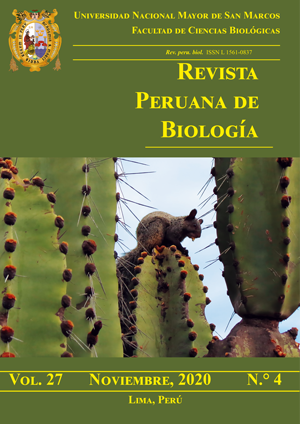Effects of forest loss on cricetid rodents in Carpish, Huánuco, Peru
DOI:
https://doi.org/10.15381/rpb.v27i4.17211Keywords:
Fragmentation, diversity, humid montane forest, Akodon, resilience, GeobosquesAbstract
Huánuco presents humid montane forests in the Carpish area, which has highly diverse flora and fauna. Among mammals, the cricetid rodents stand out for their high diversity; however, these forests have been being increasingly fragmented by the opening of roads, agriculture, and livestock. Despite the accelerated reduction of these forests, the effect of the anthropic disturbances on cricetid rodents —which are fundamental in their role as preys, predators, and seed dispersers in the environment they inhabit— is not known; therefore, this research examines the effect of the forest loss on the diversity and richness of the cricetid rodent species. The evaluations of the study area, San Pedro de Carpish, correspond to the years 2002 and 2017. Forest loss was examined with quantitative and qualitative data obtained from the “Geobosques” platform through a spatial and temporal analysis. The results show that diversity was constant, and richness decreased in two species from the total recorded; beta diversity indicated a similar species composition and replacement in two species in the evaluated years. It is important to point out the resilience of the species in these forests, although their responses are different to anthropic disturbance, such as Akodon kotosh, which exhibited high abundance despite forest loss and increased anthropic disturbance between the evaluated years; but in turn, the change in the composition of the species directly affects the structure or forest composition, which is why conservation actions and adequate management plans are recommended for agriculture and livestock present in the area.
Downloads
Downloads
Published
Issue
Section
License
Copyright (c) 2020 Maggie Noblecilla Huiman

This work is licensed under a Creative Commons Attribution-NonCommercial-ShareAlike 4.0 International License.
AUTHORS RETAIN THEIR RIGHTS:
a. Authors retain their trade mark rights and patent, and also on any process or procedure described in the article.
b. Authors retain their right to share, copy, distribute, perform and publicly communicate their article (eg, to place their article in an institutional repository or publish it in a book), with an acknowledgment of its initial publication in the Revista Peruana de Biologia.
c. Authors retain theirs right to make a subsequent publication of their work, to use the article or any part thereof (eg a compilation of his papers, lecture notes, thesis, or a book), always indicating its initial publication in the Revista Peruana de Biologia (the originator of the work, journal, volume, number and date).






